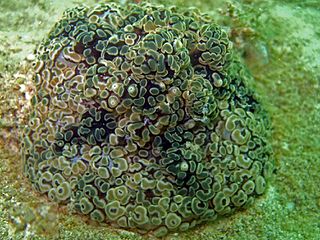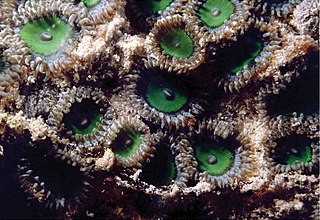 W
WAcanthicolepis is a genus of marine annelids in the family Polynoidae. The genus was described in 1990 and includes two short-bodied species with up to 50 segments and which occur in the Mediterranean Sea and North-east Atlantic Ocean.
 W
WAlicia sansibarensis, commonly known as tuberculate night anemone, is a species of sea anemone in the family Aliciidae. It is found in the Indian and Pacific Oceans. Alicia sansibarensis have tentacles that are very long and snake, which are used for the protection of crownfish from predators.
 W
WBathochordaeus charon is a species of giant larvacean, a solitary, free-swimming tunicate that filter feeds in surface waters. The species was named after Charon, the mythical Greek ferryman who carried the souls of the dead across the rivers dividing the world of the living from the world of the dead.
 W
WClavelina picta, common name the painted tunicate, is a species of tunicate, in the genus Clavelina. These animals, like all ascidians, are sessile filter feeders.
 W
WOdontosyllis enopla, commonly known as the Bermuda fireworm, is a polychaete worm that inhabits shallow areas of the western Atlantic Ocean. The organism is bioluminescent when it rises to the surface of the sea during its mating period. It is possible that this fireworm is the explanation of a candle-like light seen by Christopher Columbus during his first voyage on 11 October 1492 before he made landfall in his explorations.
 W
WRicordea yuma is a species of coral in the family Ricordeidae, order Corallimorpharia; This order of corals do not produce the distinctive calcification of the closely related Scleractinian, or reef building corals. Ricordea yuma are found on the sea floor in relatively shallow, tropical or subtropical ocean environments. Distinctive features include a large mouth disk that takes up most of the organism, and brightly colored tentacles. Ricordea yuma can reproduce both sexually, and asexually by budding a new coral with replicated elements from the mother coral. This may be one mechanism of how they are able to spread and overtake areas rapidly; They have been observed being competitively successful at monopolizing areas by excluding reef-building coral species, after a disturbance in the substrate.
 W
WSterechinus neumayeri, the Antarctic sea urchin, is a species of sea urchin in the family Echinidae. It is found living on the seabed in the waters around Antarctica. It has been used as a model organism in the fields of reproductive biology, embryology, ecology, physiology and toxicology.
 W
WThe sun-burst soft coral is a species of colonial soft corals in the family Alcyoniidae. It is the only species known in the genus Malacacanthus.
 W
WXenylla grisea is a species of springtails in the family Hypogastruridae.
 W
WZoanthus sansibaricus is a species of zoanthid generally found in the Indo-pacific but also off the western coast of South America. The range of habitation has been noted in intertidal zones along with areas below 7 m, but shows phenotypical and morphological differences based on depth and shading. Shaded individuals contain larger polyps compared to unshaded. It can be divided into three reproductive categories, male, female and asexual. Spawning has been observed within the middle of July, using lunar phases as an indicator. Various subclades are theorized to appear based on the time of year.